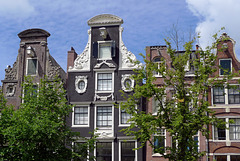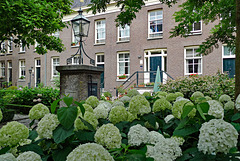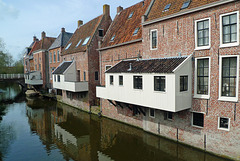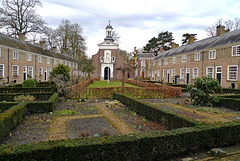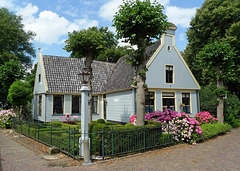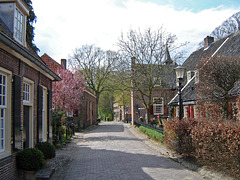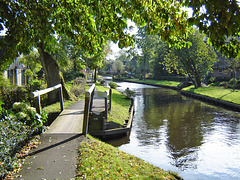
Nederland: steden en dorpen
Folder: Nederland - the Netherlands
Foto's van Nederlandse steden en dorpen.
Nederland - Alkmaar, kaasmarkt
| |
|
|
|
The kaasmarkt (cheese market) in Alkmaar is one of the most well known attractions in the Netherlands. Although very touristy is a visit to the market worthwhile.
Almost 700 years ago, Alkmaar was already a cheese town. Based on historical records it appears that the city owned one pair of cheese scales in the year 1365, but this increased to four in 1612. Thee cheese carrier’s guild is first mentioned seven years later. However the year of 1593 is considered the start of the cheese market. Since the beginning it has always taken place on the Waagplein at the foot of the beautiful Waag (Weigh House).
In the 17th century, cheese was traded on Fridays and Saturdays from May until All Saint’s Day. In the 18th century there were cheese markets on four days a week, which lasted until one o’clock at night. The square was gradually becoming too small for all the cheese. Markets were the economic engine in those days, so houses were sometimes demolished to increase market space.
Nowadays the folkloric cheese market is a show put on for tourists from around the world, rather than an active center of trade in cheese. From April to September inclusive, one can find out how cheese is traded according to the century-old traditions every Friday from 10am.
Nederland - Amsterdam, Grachtengordel
| |
|
|
|
Amsterdam has more than one hundred kilometers of canals, about 90 islands and 1500 bridges. The ‘Grachtengordel’ (Canal Ring Area) does exist of the Singel - in the Middle Ages a moat around the oldest parts of the city - and the main canals Herengracht, Prinsengracht, and Keizersgracht. These three canals - dug in the 17th century during the so called Dutch Golden Age - form a concentric belt around the city.
The area around the city's main canals is an international icon of urban planning and architecture, which is still intact after four centuries. The area is known for its small bridges going over the canals and 17th-century canal homes. UNESCO added the Canal Ring Area in August 2011 to the World Heritage List.
Pictures:
main photo: façades of canal houses along de Prinsengracht, nearby Brouwersgracht
note 1: Herengracht
note 2: Prinsengracht
note 3: Keizersgracht
For more information: www.canalsamsterdam.com
Nederland - Amsterdam, Begijnhof
| |
|
|
|
Begijnhof is the only almshouse founded in medieval Amsterdam, located within the innermost canal the ‘Singel’. Begijnhof is not an ordinary almshouse as it was not founded by private persons. It bore closer resemblance to a convent, although the beguines enjoyed more freedom than nuns in a convent. They were a group of unmarried or widowed women who lived together in a close community under a vow of chastity, but were free to leave the court at any time in order to get married. The ‘begijntjes’ (beguines) received free lodging for caring the sick and educating the poor in Amsterdam.
It is unclear when the Beguinage was founded. The beguines lived in 1346 still in one house; in a document called "Beghynhuys". In 1389 for the first time is spoken of a courtyard.
Begijnhof doesn’t have the small houses, so characteristic for most of the Dutch almshouses, but exist of 47 ordinary townhouses, each with facades from the 17th and 18th century (PiP 1). Most of the houses are older and quite a lot of them still have a Gothic timber frame. One of the oldest wooden houses of Amsterdam - Houten Huys from 1528 - is located within the Begijnhof (PiP2).
The Begijnhof Chapel features a series of panels telling the story of the Miracle of Amsterdam. For more info and pictures about this chapel see: www.ipernity.com/doc/294067/41236526
Nowadays the houses in Begijnhof are still occupied by single women. The secluded courtyard is a green oasis, surrounded by the hustle and bustle of the city centre of Amsterdam.
Nederland - Amsterdam, Hofje van Brienen
| |
|
|
|
A Dutch hofje is a complex of almshouses around a central courtyard. They were built since the Middle Ages as a charity to house needy or elderly men and women. Amsterdam still has about 30 hofjes ; most of them can be found in or around the Jordaan neighbourhood.
Hofje van Brienen - or officially Het Brienens Gesticht de Star , was founded by Arnoud Jan van Brienen and his wife Sophia Maria Half-Wassenaar . In 1797 they commissioned the city architect of Amsterdam to design this hofje and to build it on the former location of beer brewery De Star . The aim was to provide housing for impoverished Roman Catholic men. Eventually the courtyard was built in 1803 and it was not until 1806 that the first inhabitants moved in.
Hofje van Brienen was completely renovated in 1997 and comprises 26 residential units. Nowadays they are inhabited by both married as unmarried, catholic and non-catholic inhabitants above the age of 45 years with a low income.
The hofje , being a hidden gem full with flowering and evergreen plants, can be visited for free.
Nederland - Appingedam, hanging kitchens
| |
|
|
|
Although almost nobody in the Netherlands would call Appingedam a city, it became its city rights already in the year of 1327. For sure the city is much older, but its date of origin is not known exactly. Together with the capital Groningen and Winschoten it is one of the three cities in the province of Groningen and located in the northern part of the Netherlands.
The name ‘Appingedam’ derived from two hamlets, ‘Appinge’ and ‘Damme’, which formed the later city; although others refer to the river ‘Apt’, in which a ‘dam’ was built.
Appingedam’s is quite famous for its hanging kitchens ('hangende keukens') and do attract many visitors. During the Golden Age the city had warehouses along the Damsterdiep. In the 17th century these warehouses were converted into private houses and due to a lack of space white painted kitchens were built over the water of the Damsterdiep. Also very practical, because the housewives could collect the water for cooking directly from the canal and after the washing up they threw the water out of the kitchen window back into the canal. Many of these houses along the Solwerderstraat are still used as private residences.
By far the best views of the ‘hanging kitchens’ are from the Vrouwenbrug (Women’s Bridge) over the Damsterdiep.
Nederland - Bergen op Zoom
| |
|
|
|
Bergen op Zoom was granted city status probably in 1212. In 1287 the city and its surroundings became a lordship as it was separated from the lordship of Breda. The lordship was elevated to a margraviate in 1559. Several noble families ruled Bergen op Zoom in succession until 1795.
The city was built on a place where two types of soil meet: sandy soil and marine clay. The sandy soil pushed against the marine clay, accumulating and forming hills over several centuries. Those ‘hills’ are called Brabantse Wal , literally meaning ‘ramparts of Brabant’; Bergen in Dutch means mountains or hills and Zoom refers to the border of these ramparts.
Bergen op Zoom became a trading city and merchants from all over Europe came to the city to sell their goods. The beautiful historical buildings on the Grote Markt (Market Square) reflect the wealth of the city.
The city hall (right) is a late Gothic building, dating back to the year of 1398; several fires put the building to ashes; the current building with its late-Gothic façade, dates from 1611. In front of the town hall stands a statue of ‘Anton van Duinkerken’, a local writer, poet and professor (PiP2). Hotel De Draak (left) is the oldest hotel in the Netherlands and is at least dating back to 1397, when a fire almost burnt down the entire city, but the inn was one of the few buildings which survived. City archives turned into ashes and smoke during this city fire, but experts say that Hotel de Draak was at least 100 years old when the city fire emerged.
Nederland - Blokzijl
| |
|
|
|
Blokzijl was mentioned for the first time in 1524 and in 1561 the village became the right as receiver of the toll by Spanish king Philip II of Spain. At the end of the 16th century Blokzijl became more and more an important trading post for peat, which was won in the hinterland and provided a lot of activity.
After the Siege of Steenwijk (1580-1581) during the Eighty Years’ War, a fortified lock (in local dialect called zijl or siel ) was built and the town was walled, creating a base for the war fleet and a base for operations for the Dutch troops against the Spaniards. The name Blokzijl - meaning fortified lock - originates from that time.
In the 17th century industry developed on and on in the form of breweries shipyards and other craft sectors. For some years Blokzijl even became city rights. The monumental houses with stepped gables date from that time.
Blokzijl is a small town with great charm due to the narrow streets, patrician houses, many picturesque corners and its beautiful harbour basin. Until 1973 it was a separate municipality, but nowadays is part of Steenwijkerland.
Nederland - Blokzijl
| |
|
|
|
Blokzijl was mentioned for the first time in 1524 and in 1561 the village became the right as receiver of the toll by Spanish king Philip II of Spain. At the end of the 16th century Blokzijl became more and more an important trading post for peat, which was won in the hinterland and provided a lot of activity.
After the Siege of Steenwijk (1580-1581) during the Eighty Years’ War, a fortified lock (in local dialect called zijl or siel ) was built and the town was walled, creating a base for the war fleet and a base for operations for the Dutch troops against the Spaniards. The name Blokzijl - meaning fortified lock - originates from that time.
In the 17th century industry developed on and on in the form of breweries shipyards and other craft sectors. For some years Blokzijl even became city rights. The monumental houses with stepped gables date from that time.
Blokzijl is a small town with great charm due to the narrow streets, patrician houses, many picturesque corners and its beautiful harbour basin. Until 1973 it was a separate municipality, but nowadays is part of Steenwijkerland.
Nederland - Breda, Begijnhof
| |
|
|
|
The Begijnhof (or officially Catharinabegijnhof Breda ) was first mentioned in 1267, but must have existed some time before that. The beguinage was moved to its current location in the centre of Breda around the year of 1535. In the 19th century, the court was expanded with a second courtyard and the single-nave St Catherine church. The walled complex of the beguinage consists of 29 houses around an herb garden with 300 different kinds of spices and lawn, which was used as bleachfield by the beguines.
The last living beguine in the Netherlands - Cornelia Catherina Frijters - died in 1990. The Begijnhof has a small museum, where one gets insight into the living of the beguines. Nowadays the houses around the courtyard can be rented, but still only by single women.
Nederland - Broek in Waterland
| |
|
|
|
Broek in Waterland is one of the villages in the Netherlands I do like very much. For me it is almost unbelievable to find such an authentic and picturesque place less than ten kilometres from Amsterdam and without the crowds in other more touristy places around.
Broek in Waterland was originally a fishermen's village and for that reason its church is dedicated to St. Nicolas (PiP 2), the patron saint of seafarers. From the mid 16th century this activity was rapidly replaced by stock farming and the production of dairy. The dairy products were transported to Amsterdam by boat. The harbour - called Havenrak (PiP3) remained important for the village and is still the heart of Broek en Waterland.
In the 17th and 18th century it was a popular village for the extremely rich (grain) merchants of this area and many impressive houses were built. The tiny village offers almost hundred meticulously renovated and preserved state monuments from the Dutch Golden Age period. Much of these traditional ‘Broeker houses’ have just one floor - due to the weak ground - and are constructed with a timber frame and walls. Much of them are nowadays painted in the famous Broeker grijs (main picture).
Broek in Waterland is surrounded by ditches and meadows and the ‘centre’ of the village is the Havenrak, a widening of the Ee rivulet (PiP4), which flows through Broek. The village has a couple of narrow streets, all lined with the traditional ‘Broeker houses’: having just one floor, due to the weak ground, constructed with a timber frame and walls and most of them are painted in the famous ‘Broeker grey’ (main picture). Some of them do have beautifully decorated entrance doors (PiP 1).
Nederland - Broek in Waterland
| |
|
|
|
Broek in Waterland is one of the villages in the Netherlands I do like very much. For me it is almost unbelievable to find such an authentic and picturesque place less than ten kilometers from Amsterdam and without the crowds in other more touristy places around.
Broek in Waterland was originally a fishermen's village and for that reason its church is dedicated to St. Nicolas , the patron saint of seafarers. From the mid 16th century this activity was rapidly replaced by stock farming and the production of dairy. The dairy products were transported to Amsterdam by boat. The harbour - called Havenrak (PiP1) remained important for the village and is still the heart of Broek en Waterland.
In the 17th and 18th century it was a popular village for the extremely rich (grain) merchants of this area and many impressive houses were built. The tiny village offers almost hundred meticulously renovated and preserved state monuments from the Dutch Golden Age period. Much of these traditional ‘Broeker houses’ have just one floor - due to the weak ground - and are constructed with a timber frame and walls. Much of them are nowadays painted in the famous Broeker grijs (Broeker Grey).
Nederland - Bronkhorst
| |
|
|
|
Bronkhorst originated around the year 1000 - and probably even earlier in the 7th century - as a fortified farming settlement. The adjacent castle was the ancestral home of the Lords of Bronckhorst, one of the most important noble families in Gelderland. Bronkhorst used to be a lordship. The earliest known lord of Bronkhorst was "Gijsbert van Bronkhorst", who was first mentioned in 1127. He and some of his descendants played an important role in the politics of the time.
The origin of Bronkhorst Castle is a motte-and-bailey castle from the 10th century: a simple wooden fortress on an artificial hill. The later castle of Bronkhorst stood on the aforementioned hill next to the town and was first mentioned in the 14th century. It was sieged several times, most notably in 1582 - during the Eighty Years War - when after nine months Dutch troops captured the castle, which was occupied by the Spanish. The castle changed hands many times, until its last owner, a merchant, had it demolished in 1828. A country house was built on the remains, which in turn was demolished in 1904.
Bronkhorst has always remained tiny. Like many towns in the county, the buildings mostly consisted of loose farms. Nevertheless, in 1482 it was granted town rights by "Gijsbert VII van Bronckhorst". In 1633, a devastating fire destroyed most of the medieval buildings. What remains is a small part of the town canal and the chapel from 1344.
Because of its open character and original street plan, Bronkhorst still has a very authentic atmosphere. The small village of Bronkhorst has no less than 38 national monuments, including several city farms, the Bronkhorstermolen , the Bronkhorsterkapel and a Jewish cemetery. Along the cobble stoned streets one will find some art galleries and shops, two restaurants and a hotel.
Although Bronkhorst is known as the smallest town in the Netherlands, it is not. With a population of around 160 inhabitants, it comes after Staverden , Eembrugge and Sint Anna ter Muiden .
Picture: 'Onderstraat', one of the 'main' streets in Bronkhorst.
Nederland - De Rijp
| |
|
|
|
If visiting the village of De Rijp (or nearby Graft ) it is almost impossible to imagine that herring, whale and merchant ships from these villages could sail directly to the sea. These nautical activities brought unprecedented prosperity to the villages. The magnificent city hall and the homes of wealthy ship owners bear witness to the style and glory of the past steeped in a long tradition of whale and herring fishing. After draining of the surrounding lakes the herring industry disappeared and it was done with the wealth of the villages.
Nowadays De Rijp is a not so well known village, which attracts not that many tourists with still centuries of history. First of all its unique town hall, which is dating back to the year of 1630. The old part of the village offers also picturesque farms, typical green half-wooden houses along small canals and narrow streets.
Nederland - Deventer
| |
|
|
|
A panorama view of the city Deventer on a wonderful autumn day.
Deventer is an old Dutch city, which was founded around the year of 768 by the English missionary Lebuinus, who built a wooden church on the east bank of the river IJssel. It became city rights in 956, after which fortifications were built around the city. On one of these strongholds the Bolwerksmolen (see: www.ipernity.com/doc/294067/47395972) was built. The city was a flourishing trade centre between 1000 and 1500, because of its harbour and its participation in the Hanseatic League.
Nederland - Deventer
| |
|
|
|
Deventer, seen from 'De Worp', with the tower of the Great or Lebuïnuschurch (Grote of Lebuïnuskerk) behind the houses along the 'Welle'.
Deventer is an old Dutch city, which was founded around the year of 768 by the English missionary Lebuinus, who built a wooden church on the east bank of the river IJssel. It became city rights in 956, after which fortifications were built around the city. The city grew to be a flourishing trade centre between 1000 and 1500, because of its harbour on the river Ijssel. Deventer joined the Hanseatic League.
Nederland - Deventer
| |
|
|
|
Image: view of the city Deventer from the opposite side of the river IJssel.
Deventer is one of the oldest Dutch cities, which was founded around the year of 768 by the English missionary Lebuinus, who built a wooden church on the east bank of the river IJssel. The church did not last long and was burned by marauding Saxons 4 years later.
Deventer became city rights in 956, after which fortifications were built around the city. On one of these strongholds the href="https://www.ipernity.com/doc/294067/47395972">Bolwerksmolen was built. Due to its advantageous position along the IJssel the city was a flourishing trade centre between 1000 and 1500, because of its harbour. Around 1500 the city joined the Hanseatic League, which brought more wealth and prosperity.
Between the 16th and 19th centuries, the river flow slowed and became shallow. This had a great effect on the level of trade that Deventer could conduct. At the same time trade was increasing in other areas of the Netherlands and this as well as the Eighty Years War played a role in the decline of the wealth of the city.
In the 1800’s Deventer was the site of many industries starting up, such as an iron foundry, heavy machinery production, bicycle and can production as well as textile industries. During World War II, the port and industrial area were heavily damaged, although the old city came through the war largely unscathed.
Nowadays Deventer still offers a great collection of heritage with for instance the oldest brick house, the oldest park and the oldest academic library of the Netherlands.
Nederland - Dordrecht, Arend Maartenszhof
| |
|
|
|
The ‘Arend Maartenszhof’ is (for me) the most beautiful almshouses in Dordrecht. It was founded in 1625 by Arend Maartenszoon - a wealthy inhabitant of the city - for poor women and widows of soldiers who died for their country. Thirty-eight cottages surround a courtyard with lots of flowers, ancient trees and a water well (see PiP) and are nowadays housing both men and women.
Nederland - Dwarsgracht
| |
|
|
|
The main ‘street’ (canal) in Dwarsgracht, a hamlet nearby more well known Giethoorn in the Dutch province of Overijssel. The place was founded before 1800 at the time of peat extraction in the area.
Dwarsgracht is a real alternative for the famous, but very touristy, town of Giethoorn. Although just 3 km's away it is a completely different world: the same canal(s), small bridges, boats and thatched roof houses, but without the crowds and hustle and bustle of Giethoorn.
Dwarsgracht has just one café restaurant ( De Otterskooi ) and this is an ideal starting point for either a boat trip with a so called 'whispering boat' or for a bike tour along the canals and lakes. At De Otterskooi you can rent them both. Or just walk along the main canal through the village and enjoy the views over the water, the houses, the flowers, the birds and further away waving reed.
Jump to top
RSS feed- Latest items - Subscribe to the latest items added to this album
- ipernity © 2007-2024
- Help & Contact
|
Club news
|
About ipernity
|
History |
ipernity Club & Prices |
Guide of good conduct
Donate | Group guidelines | Privacy policy | Terms of use | Statutes | In memoria -
Facebook
Twitter


